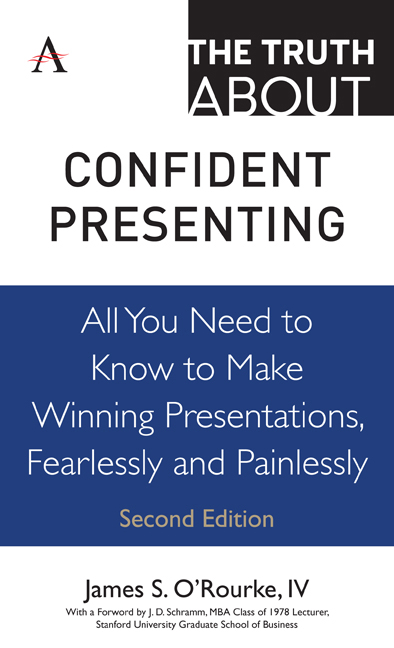 The Truth about Confident Presenting
The Truth about Confident Presenting Book contents
- Frontmatter
- Contents
- Foreword
- Introduction
- Part I Some Initial Truths
- Part II The Truth About Getting Ready to Speak
- Part III The Truth About What Makes People Listen
- Part IV The Truth About Developing Support for Your Presentation
- Part V The Truth About Getting Up to Speak
- Part VI The Truth About Managing Anxiety
- Part VII The Truth About Nonverbal Communication
- Truth 36 Most information is transferred nonverbally
- Truth 37 The nonverbal process can work for you
- Truth 38 Nonverbal communication has specific functions
- Truth 39 Nonverbal communication is governed by key principles
- Truth 40 Nonverbal communication has an effect on your audience
- Part VIII The Truth About Visual Aids
- Part IX The Truth About Handling an Audience
- Part X The Truth About What Makes a Presentation Work
- References
- Acknowledgments
- About the Author
Truth 37 - The nonverbal process can work for you
from Part VII - The Truth About Nonverbal Communication
- Frontmatter
- Contents
- Foreword
- Introduction
- Part I Some Initial Truths
- Part II The Truth About Getting Ready to Speak
- Part III The Truth About What Makes People Listen
- Part IV The Truth About Developing Support for Your Presentation
- Part V The Truth About Getting Up to Speak
- Part VI The Truth About Managing Anxiety
- Part VII The Truth About Nonverbal Communication
- Truth 36 Most information is transferred nonverbally
- Truth 37 The nonverbal process can work for you
- Truth 38 Nonverbal communication has specific functions
- Truth 39 Nonverbal communication is governed by key principles
- Truth 40 Nonverbal communication has an effect on your audience
- Part VIII The Truth About Visual Aids
- Part IX The Truth About Handling an Audience
- Part X The Truth About What Makes a Presentation Work
- References
- Acknowledgments
- About the Author
Summary
Audience members pay attention to a number of things as they listen to a presentation, including the words the speaker is saying, the rate at which they're spoken, the emphasis given to certain words, the depth and strength of the speaker's voice, the confidence and sincerity the speaker conveys, and much more.
The audience also pays attention to the context in which the presentation takes place. How are the seats arranged? Are they comfortable? Is the room warm or cool enough? Can all members of the audience see the speaker adequately? Can they hear the speaker? Many of them aren't paying attention to verbal issues, or the words that the speaker is saying. Much of what they are focusing on has little to do with the verbal message. These nonverbal cues are important to the audience, though, or they wouldn't pay attention to them.
How does the process of communicating nonverbally work? You can't go to a dictionary to look up a gesture or a facial expression. Human movement, eye contact and vocal tone don't always have a direct verbal translation. So what's going on here? Nonverbal communication is really a three-step process involving a cue, your own expectations and an inference.
Cue. You look first for a wordless cue: a motion, perhaps, or an object. For example, on arriving at work in the morning, you notice a co-worker who is glum, sullen and withdrawn. You say “Good morning,” but he doesn't reply. Your cues are nonverbal: the facial expression, his body posture and his failure to respond to your greeting.
Expectation. We then match the cues against your expectations, asking what seems reasonable or what seems obvious, based on your prior experiences. Since your co-worker is normally cheerful, talkative and outgoing, your expectations conflict with the cues you've just picked up. Your expectations are important, because you won't know what to make of a cue if you have no prior experience with it. For example, 37 when you meet someone new, or when you travel to a foreign country for the first time, you're not entirely sure what to expect.
- Type
- Chapter
- Information
- The Truth about Confident PresentingAll You Need To Know To Make Winning Presentations, Fearlessly And Painlessly, pp. 147 - 150Publisher: Anthem PressPrint publication year: 2019


